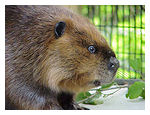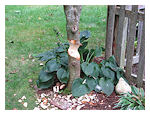General Info
Size: 3ft body length
Height at the Shoulders: 15 in
Weight: 35-66lbs

The beaver is the largest member of the rodent family. It is 2 feet long not including its tail. The beaver has a ten-inch tail that is covered with scaly skin. It is ¾ inches thick. It uses the tail as a rudder in the water. Their fur is dark brown. It has a round body, strong head, and powerful jaws. The beaver has two cutting teeth that will continue to grow throughout its life. These teeth are used to cut trees. The beaver has a total of 20 teeth. The beaver has small ears, eyes, and front legs. They have webbed skin between its toes for swimming.[/restab] [restab title=”Habitat”]Beavers live in streams, rivers, marshes, ponds, and shorelines of large lakes. They live in colonies and must live near running water with many trees along its banks. They work as a colony to build their home. Their home, which is called a lodge, has up to several entrances, and is about 3 to 6 feet high and about 7 feet across. The lodge has two rooms. One is a living room that is above the water, where the beaver sleeps. The other room is a storage room, which is underwater. The beaver often builds a dam if the water level is too low for its lodge. They do this by piling up mud, rocks, and tree branches
Damage

In urban areas, homeowners are shocked at the damage a beaver can do to their trees. Trees that once provide great shade and beauty are quickly damaged. Human and beaver objectives often clash and although they provide ecological benefits, these benefits can also threaten our agriculture and transportation. Their activity has damaged timber, crops, ornamental plants, and even buildings. Beaver dams may block drainage systems causing crops and roads to flood. It can also cause water contamination. Beavers cause millions of dollars of damage annually.
Disease
It is important to control beavers since they are carriers of Tularemia and Giardiasis. Tularemia is a bacterial disease that can be contracted by handling infected animal carcasses; eating or drinking contaminated food or water, or even breathing it in.
Control
Trapping still remains the most effective way of controlling beaver population in urban areas. Animal removal is our specialty and we include trapping beaver as part of our wildlife control program. Our wildlife control experts are trained in humane beaver trapping and removal. Don’t wait for beavers to damage your trees, schedule a free estimate with Metro Guard today.


Follow Us